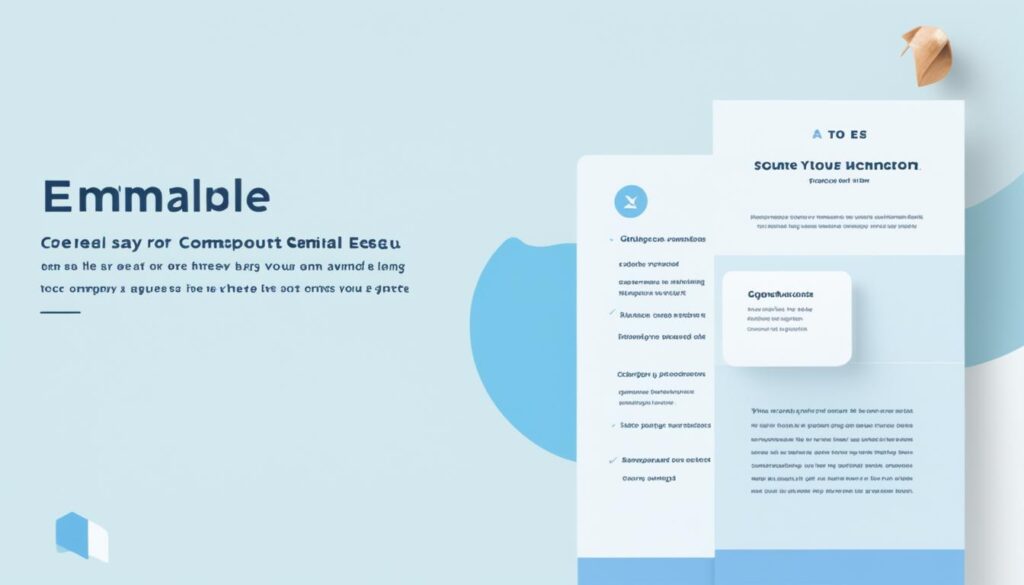Learning how to apologize to a customer for bad service is essential for businesses that want to maintain customer satisfaction and loyalty. When customers have a negative experience, it is crucial to address their concerns and demonstrate your commitment to improving their experience. By effectively apologizing, you can reduce customer churn and enhance customer relationships.
However, it is important to avoid common apology mistakes that can undermine the effectiveness of your apology. Insincere apologies or compensation alone may not be sufficient to repair the damage done. Instead, you need to offer sincere apologies, take ownership of mistakes, and provide appropriate solutions to win back customer trust. Additionally, following up with customers to ensure their satisfaction is key to rebuilding the relationship.
In this article, we will explore the importance of apologizing to customers, common mistakes to avoid when apologizing, best practices for offering an apology, templates to guide your apology, and the benefits of apologizing to upset customers.
Key Takeaways:
- Apologizing to customers for bad service is crucial for maintaining satisfaction and loyalty.
- Avoid common apology mistakes such as insincere apologies or providing compensation alone.
- Offer sincere apologies, take ownership of mistakes, and provide appropriate solutions.
- Follow up with customers to ensure their satisfaction and rebuild the relationship.
- Apologizing to upset customers can salvage relationships, improve satisfaction, and increase loyalty.
The Importance of Apologizing to Customers
Apologizing to customers is crucial for maintaining customer satisfaction, preserving brand reputation, and fostering customer loyalty. When negative experiences occur, addressing and resolving customer complaints through sincere apologies can prevent these incidents from leading to customer churn. Meeting customer expectations and providing appropriate compensation when necessary are key elements in ensuring a positive customer experience.
Customer satisfaction is closely tied to brand reputation. When businesses take the time to sincerely apologize for any mistakes or inconveniences, customers feel valued and heard. This, in turn, can lead to increased customer loyalty and retention.
In addition to preventing negative experiences from impacting customer relations, apologies also provide an opportunity to gather valuable customer feedback. By actively listening to customers’ concerns and feedback, businesses can identify areas for improvement and make necessary changes to enhance their products or services.
However, it is crucial to avoid insincere apologies, as they can further damage the customer relationship. Customers can easily detect insincerity, and it undermines their trust in the brand. Providing genuine and heartfelt apologies demonstrates a commitment to customer satisfaction and helps to rebuild their trust in the brand.
Overall, recognizing the importance of apologizing to customers is essential for businesses aiming to maintain positive customer relationships, foster loyalty, and improve their brand reputation. By addressing issues promptly, sincerely, and appropriately, businesses can ensure customer satisfaction, retention, and loyalty.

Common Mistakes to Avoid When Apologizing
When apologizing to a customer for bad service, it is important to avoid common mistakes that can undermine the effectiveness of the apology. These mistakes not only fail to resolve the issue but can also further damage the customer relationship. By being mindful of these missteps, you can ensure that your apologies are sincere and impactful.
Playing down customer’s feelings
One mistake to avoid is downplaying the customer’s feelings. Even if you disagree with the customer’s perspective, it is crucial to acknowledge their emotions and demonstrate empathy. By validating their concerns, you show that you value their experience and are committed to finding a resolution.
Failing to admit mistakes
Another common mistake is failing to take responsibility for mistakes. Customers appreciate transparency and honesty. By admitting your errors, you build trust and show that you are accountable for the service provided.
Making unrealistic promises
When apologizing, it is important to avoid making unrealistic promises. Promising that the issue will never happen again or guaranteeing an immediate solution may create false expectations. Instead, be realistic about what you can offer and focus on taking tangible steps to address the problem.
Vague apologies
Vague apologies can come across as insincere and dismissive. It is essential to provide specific apologies that address the customer’s particular concern. By acknowledging the specific issue and expressing regret for the impact it had on the customer, you demonstrate that you understand their experience.
Excessive apologies
While apologies are necessary, excessive apologies can become ineffective. Constantly repeating apologies without taking action may frustrate the customer. Instead, focus on addressing the problem and offering a solution that shows your commitment to making things right.
Begrudging apologies
Apologizing with resentment or reluctance can be detrimental to the customer relationship. Begrudging apologies lack sincerity and may only exacerbate the issue. It is important to approach apologies with an open mind and a genuine desire to rectify the situation.
Compensation instead of apology
Lastly, offering compensation instead of a genuine apology can be seen as a superficial attempt to placate the customer. While compensation may be appropriate in some cases, it should not replace the apology itself. Apologizing sincerely and addressing the underlying problem is crucial for repairing the customer relationship.
By avoiding these common apology mistakes, you can ensure that your apologies are meaningful, sincere, and effective in repairing customer relationships. A genuine apology can go a long way in restoring trust and loyalty.
Best Practices for Apologizing to Customers
When it comes to apologizing to a customer for bad service, following best practices is crucial to ensure a successful resolution. By offering a sincere apology, taking ownership of mistakes, explaining what happened, offering a solution or resolution, and following up with the customer, you can demonstrate your commitment to resolving the issue and maintaining a positive customer relationship.
Steps for a Sincere Apology:
- Take ownership of mistakes: Admit any errors or oversights on your part. This shows accountability and sincerity.
- Explain what happened: Provide a clear and concise explanation of the situation. Transparency helps rebuild trust.
- Offer a solution: Propose a solution or resolution that addresses the customer’s concerns. This shows your commitment to making things right.
- Follow up with the customer: After resolving the issue, check in with the customer to ensure their satisfaction. This demonstrates your dedication to their experience.

By following these apology best practices, you can navigate challenging situations with sincerity and professionalism. Remember, a sincere apology goes a long way in maintaining customer trust and loyalty.
Templates for Apologizing to Customers
When it comes to apologizing to customers for various issues, having ready-to-use apology templates can be a time-saving and efficient solution. These templates can be personalized to address specific situations, such as a customer service experience, a website or system outage, a late or lost shipment, or a wrong order.
Expressing genuine regret and taking responsibility for the mistake are vital elements of a successful apology. It’s also important to explain what went wrong and offer alternatives or solutions to rectify the situation. By avoiding generic templates and tailoring the apology letter to the individual customer, businesses can convey a sense of sincerity and prioritize their satisfaction.
Personalized apology letter templates allow businesses to show empathy and concern while seeking to repair the customer relationship. These templates serve as a foundation for crafting an apology that highlights the customer’s importance and demonstrates a commitment to resolving the issue at hand.
To further illustrate the efficiency of personalized apology templates, here is an example of a personalized apology letter template:
Personalized Apology Letter Template
| Situation: | Customer Service Experience |
|---|---|
| Mistake: | Delayed response to customer inquiry |
| Template: |
Dear [Customer’s Name], I wanted to personally apologize for the delay in responding to your recent inquiry. We understand how frustrating it can be to wait for assistance, and we deeply regret any inconvenience it may have caused. Please know that we value your time and your feedback. We are actively working on improving our response time to ensure that no customer has to experience this delay again in the future. In the meantime, I would like to offer you our sincerest apologies and assure you that your inquiry is important to us. For the inconvenience caused, we would like to provide you with a [specific compensation or offer] as a token of our apology and appreciation for your patience. If you have any further questions or concerns, please do not hesitate to reach out to me directly at [contact information]. Thank you for bringing this matter to our attention, and we look forward to serving you better in the future. Best regards, [Your Name] |
By utilizing personalized apology letter templates, businesses can effectively address customer concerns, make amends for mistakes, and reinforce their dedication to providing exceptional customer service.
The Benefits of Apologizing to Upset Customers
Apologizing to upset customers can have numerous benefits for your business. By addressing their concerns and demonstrating a genuine desire to resolve any issues, you have the opportunity to salvage customer relationships, improve customer satisfaction, and increase customer retention and loyalty.
When customers are dissatisfied or have had a negative experience, they often share their feedback with others. This negative feedback can spread quickly through social media and other channels, impacting your brand reputation. By promptly apologizing and taking steps to rectify the situation, you can prevent the escalation of negative feedback and mitigate any potential damage to your reputation.

Apologies also provide an opportunity to show personalized care and empathy towards your customers. By acknowledging their concerns and providing a listening ear, you demonstrate that their satisfaction and happiness are important to you. This personalized approach can help build customer trust and loyalty, as customers appreciate businesses that take the time to understand and address their individual needs.
In addition to addressing immediate customer concerns, your apology can also serve as an invitation for feedback. By offering channels for customers to provide their input and suggestions, you create an environment of open communication. This feedback can be invaluable in identifying areas for improvement and enhancing the overall customer experience.
Managing customer complaints and feedback is made easier with complaint management software. This software allows you to streamline and centralize the complaint handling process, ensuring that every customer concern is addressed promptly and effectively. By implementing complaint management software, you can demonstrate your commitment to customer satisfaction and efficiently resolve any issues that arise.
An apology provides you with the opportunity to turn a negative customer experience into a positive one. By resolving their complaints and concerns, you can create a positive customer experience that showcases your dedication to customer care and fosters long-term loyalty.
In conclusion, apologizing to upset customers has multiple benefits, including salvaging customer relationships, improving satisfaction and retention, preventing negative feedback, and enhancing the overall customer experience. By showing personalized care and utilizing customer feedback channels, you can strengthen customer trust and loyalty, ultimately contributing to the success and growth of your business.
How to Draft a Successful Apology Letter
Drafting a successful apology letter involves several key steps. To ensure your apology is effective and sincere, follow these guidelines:
- Express regret: Begin your apology letter by clearly expressing your regret for the mistake or negative experience the customer had.
- Admit the mistake: Take ownership of the error and acknowledge the specific mistake or wrongdoing that occurred.
- Explain what happened: Offer a brief explanation of the situation, outlining the circumstances that led to the issue.
- Understand customer goals: Show empathy and understanding for the customer’s goals and expectations, demonstrating that you value their perspective.
- Repair the wrongdoing: Propose a solution or action plan to rectify the mistake and prevent it from happening again in the future.
- Ask for feedback: Encourage the customer to provide feedback about their experience, offering them a platform to share their thoughts or suggestions for improvement.
- Follow up if necessary: Close the apology letter by expressing your commitment to resolving the issue and ensuring the customer’s satisfaction. Offer contact information or an invitation to reach out if they have any further concerns.
An apology email template can provide a helpful structure for your apology letter. Feel free to tailor the template to the specific situation and customer, adding personal touches to make the apology more meaningful and sincere.
To further illustrate how to draft a successful apology letter, here is an example of an apology email template:
| Subject: | Apology for [Specific Issue] |
|---|---|
| Dear [Customer’s Name], |

|
[Insert personalized opening],
I want to express my deepest regrets for the [specific issue] you experienced with our [product/service]. We take full responsibility for the mistake, and I am truly sorry for any inconvenience or frustration this may have caused you.
I understand the importance of [customer’s goal] to you, and the impact that [specific issue] had on achieving that. Please rest assured that we are working diligently to rectify the situation and prevent similar occurrences in the future.
[Explain any relevant details about what happened and why. Be transparent and honest about the circumstances surrounding the mistake.]
Your satisfaction is our top priority, and we value your feedback. Please let us know how we can further assist you or address any concerns you may have. We are open to any suggestions or additional actions that we can take to regain your trust.
Thank you for your understanding and patience. We appreciate your ongoing support and look forward to the opportunity to serve you better in the future.
Best regards,
[Your Name]
[Your Position/Title]
[Company Name]
Examples of Apology Letters for Various Situations
When it comes to apologizing to customers for different situations, using apology letter examples can be invaluable. These examples provide guidance on how to personalize your apology, offer appropriate compensation when necessary, and follow up with customers to ensure their satisfaction. By adopting a customer-centric approach and addressing the specific concerns of each situation, you can effectively apologize and maintain positive customer relationships.
For instance, imagine a customer received a wrong order. In your apology letter, you can acknowledge the mistake, express your regret, and assure the customer that corrective measures will be taken immediately. To demonstrate your commitment to their satisfaction, you could offer a replacement or refund, along with a personalized message to show that you value their business.
In another scenario where a customer experienced a late shipment due to a service outage, your apology letter can convey empathy for the inconvenience caused. You can explain the situation, apologize sincerely, and offer compensation, such as a discount on their next purchase or free shipping on a future order. Taking the time to follow up with the customer after the resolution also reinforces your dedication to their satisfaction.
Remember, a well-crafted apology letter can go a long way in repairing relationships with unsatisfied customers. By personalizing your message, compensating appropriately, and following up diligently, you can restore trust and foster long-term loyalty. Keep in mind the importance of a customer-centric approach, making them feel heard, valued, and confident in your commitment to delivering exceptional service.
FAQ
How important is it to apologize to upset customers?
Apologizing to upset customers is crucial for maintaining customer satisfaction, preserving brand reputation, and fostering customer loyalty. Apologies help to address and resolve customer complaints, meet customer expectations, and prevent negative experiences from leading to customer churn.
What are some common mistakes to avoid when apologizing?
Common mistakes to avoid when apologizing include downplaying the customer’s feelings, failing to take responsibility for mistakes, making unrealistic promises, offering vague apologies, apologizing excessively, giving begrudging apologies, and providing compensation instead of a genuine apology.
What are the best practices for apologizing to customers?
Best practices for apologizing to customers include offering a sincere apology, taking ownership of mistakes, explaining what happened, offering a solution or resolution, and following up with the customer. It is also recommended to use a sincere apology template to guide the apology process.
Are there templates available for apologizing to customers?
Yes, there are ready-to-use apology templates available for various situations such as customer service experience, website or system outage, late or lost shipment, or a wrong order. These templates can be personalized to the specific situation to convey genuine concern and show customers that their satisfaction is a top priority.
What are the benefits of apologizing to upset customers?
Apologizing to upset customers can help salvage customer relationships, improve customer satisfaction, and increase customer retention and loyalty. It also provides an opportunity to prevent negative feedback from spreading through social media and other channels and helps in building customer trust.
How to draft a successful apology letter?
To draft a successful apology letter, it is important to express regret, admit the mistake, explain what happened, understand the customer’s goals and expectations, offer a solution or plan to repair the wrongdoing, ask for feedback to improve future service, and follow up if necessary to ensure customer satisfaction.
Can you provide examples of apology letters for various situations?
Yes, there are examples of apology letters available for different situations such as a wrong order, late shipment, service outage, or an unsatisfied customer. These examples demonstrate the importance of personalization, offering compensation when appropriate, and following up with customers to ensure their satisfaction.
